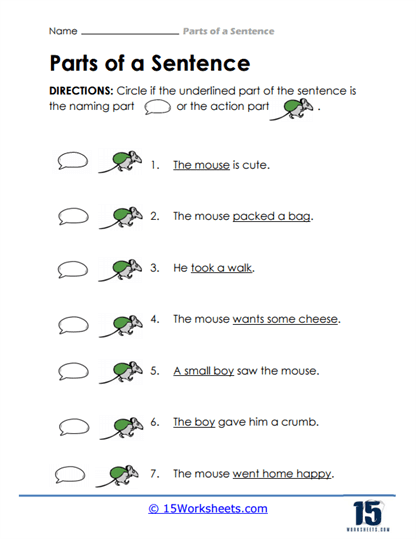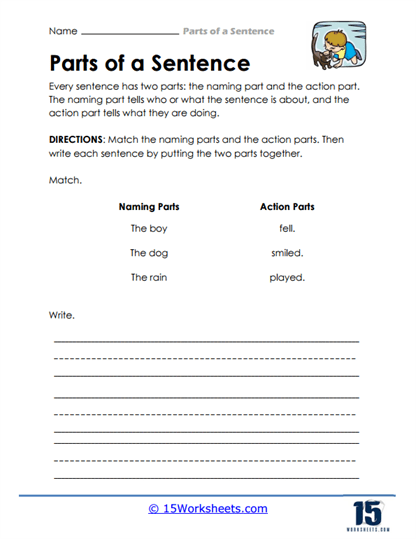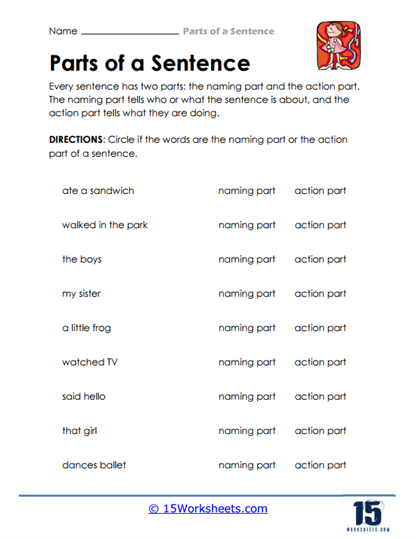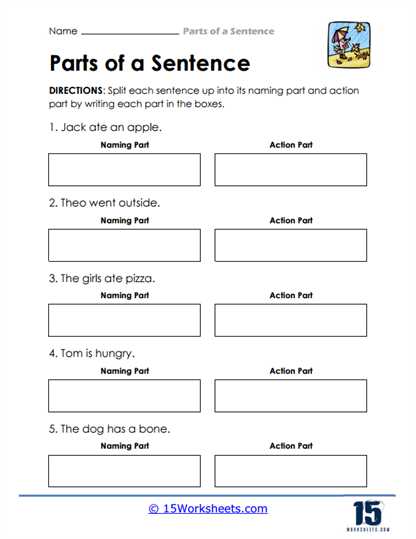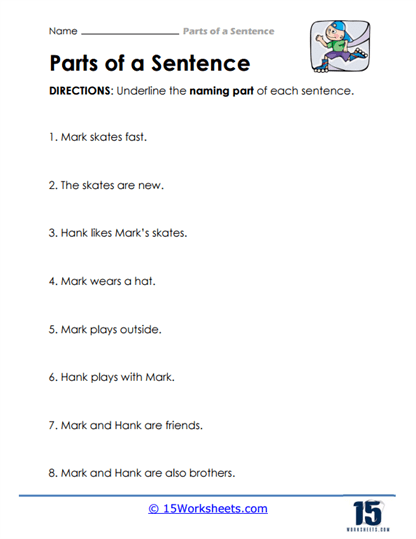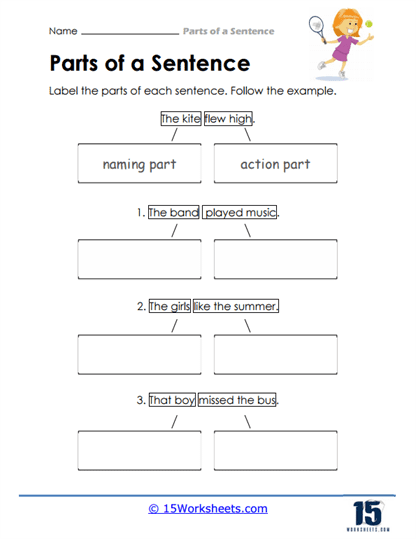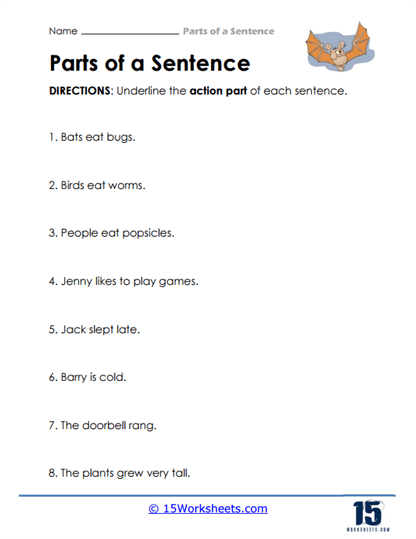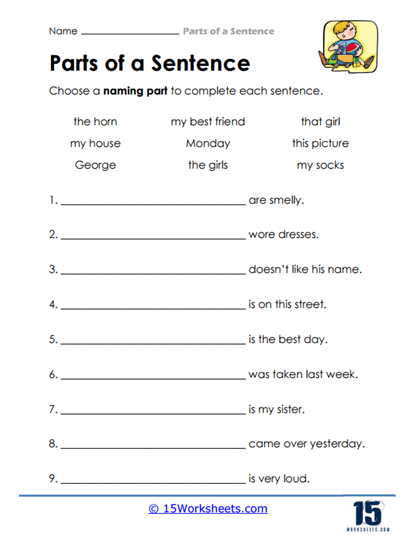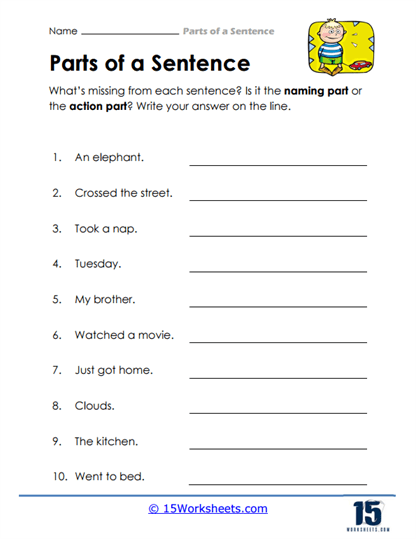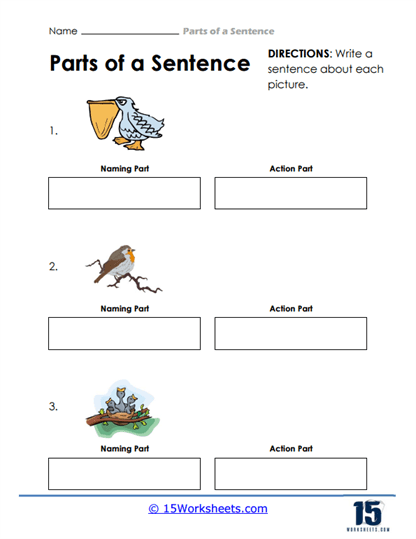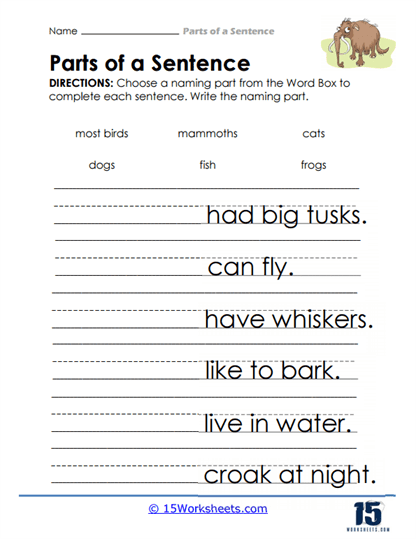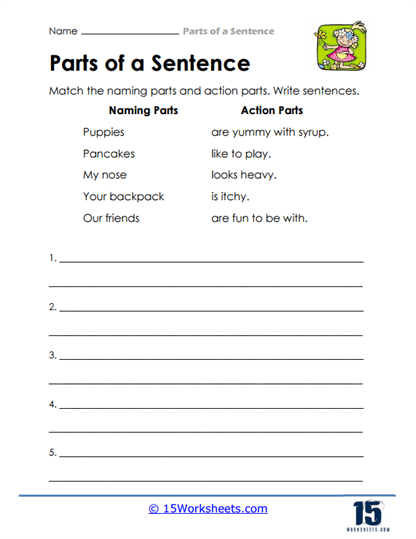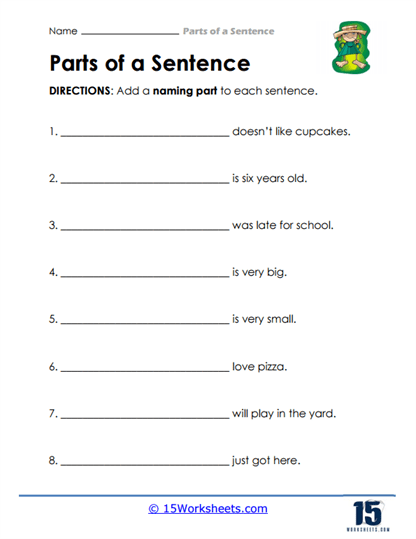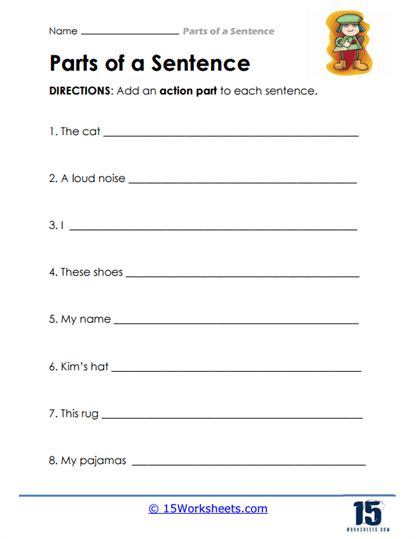Parts of a Sentence Worksheets
About These 15 Worksheets
This collection of worksheets is an invaluable resource for students, teachers, and homeschoolers looking to strengthen their understanding of sentence structure. Each worksheet focuses on the fundamental components of a sentence, namely the “naming part” (subject) and the “action part” (predicate), providing a variety of engaging activities that reinforce these concepts in a clear and practical way. These worksheets are thoughtfully designed to cater to different learning styles and are suitable for a range of grade levels, making them an essential tool in any educational setting.
Key Features and Activities
Matching Exercises – One of the primary activities featured in this collection is the matching exercise. Students are presented with a list of naming parts and action parts. Their task is to draw connections between them to form complete sentences. This activity encourages critical thinking as students must ensure that the naming part logically fits with the action part. For example, matching “The dog” with “is barking” forms a coherent sentence, reinforcing the student’s understanding of how subjects and predicates work together.
Sentence Completion – Another popular type of worksheet in this collection involves sentence completion. Here, students are given either a naming part or an action part and are required to complete the sentence by adding the missing part. This exercise challenges students to think creatively while adhering to grammatical rules. It is particularly effective in helping students internalize the structure of a sentence, as they must consider both the meaning and grammatical correctness of their additions.
Identifying Sentence Parts – These worksheets also include activities where students are asked to identify the naming and action parts within sentences. In some exercises, parts of a sentence are underlined, and students must circle whether it is a naming part or an action part. This activity sharpens their analytical skills and deepens their understanding of sentence components by encouraging them to dissect sentences.
Sentence Splitting – Another engaging activity involves sentence splitting, where students are given full sentences and asked to break them down into their naming and action parts. This exercise is a great way to reinforce the concept that every sentence is composed of these two essential components. By repeatedly breaking down sentences, students gain a clearer understanding of how sentences are constructed, which in turn improves their writing and comprehension skills.
Fill-in-the-Blanks – The fill-in-the-blanks activity is a versatile tool in this collection. Students are provided with sentences that have either the naming part or the action part missing. Their task is to complete these sentences by filling in the blanks with appropriate words. This activity not only reinforces their knowledge of sentence structure but also expands their vocabulary and encourages them to think critically about word choice.
Choosing the Correct Part – In some worksheets, students are asked to choose the correct naming or action part from a list of options to complete a sentence. This type of activity is particularly useful for students who are still mastering the basics of sentence structure. It guides them to make the right choices while allowing them to see how different options can change the meaning of a sentence.
Sentence Writing – A more advanced activity in the collection involves sentence writing, where students are given a naming part and an action part and must combine them into a complete sentence. This exercise is an excellent way for students to apply what they’ve learned and to practice writing clear, grammatically correct sentences. It also encourages them to think about sentence variety and complexity, which are crucial skills for more advanced writing.
This comprehensive collection of worksheets doesn’t stop at the basics. To ensure a well-rounded understanding of sentence construction, the collection also includes:
Sentence Building – Worksheets that allow students to build sentences from a selection of words, ensuring that they correctly pair naming parts with action parts.
Scrambled Sentences – Students are given jumbled words and must rearrange them into a coherent sentence, helping them understand sentence structure in a fun and interactive way.
Sentence Expansion – Activities where students start with a basic sentence and add details, enhancing their understanding of sentence complexity.
Error Correction – Worksheets where students must identify and correct errors in sentence structure, further reinforcing their grammatical knowledge.
From matching and identifying sentence parts to sentence completion and writing, these worksheets provide ample practice to help students master the foundational elements of English grammar. With the added benefits of accessibility and the potential for creative application in both teaching and learning, this collection is a must-have for anyone looking to enhance their students’ language skills.
What Are The Parts Of a Sentence?
In English grammar, a sentence is composed of various parts that work together to convey a complete thought. The two fundamental parts of a sentence are the subject and the predicate. The subject, often referred to as the “naming part,” indicates who or what the sentence is about. It usually includes a noun or pronoun and can sometimes be accompanied by modifiers such as adjectives. The predicate, known as the “action part,” tells what the subject does or describes the subject’s state of being. The predicate typically includes a verb and may also contain objects, complements, or adverbs that provide additional information about the action or state.
Beyond these basic components, a sentence can also include objects, which are nouns or pronouns that receive the action of the verb. Objects can be direct (directly affected by the action) or indirect (benefiting from the action). Additionally, complements are used to complete the meaning of a subject or verb, providing further detail or description. These can be subject complements, which rename or describe the subject (e.g., in the sentence “She is a teacher,” “a teacher” is a subject complement), or object complements, which rename or describe the object (e.g., “They elected her president,” where “president” is an object complement).
Modifiers, such as adjectives and adverbs, play a crucial role in adding detail and clarity to the parts of a sentence. Adjectives modify nouns and pronouns, providing information about qualities, quantities, or states, while adverbs modify verbs, adjectives, or other adverbs, explaining how, when, where, or to what extent an action is performed.
Phrases and clauses can be part of a sentence’s structure. A phrase is a group of words that work together as a unit but do not contain both a subject and a predicate, whereas a clause does include both. Clauses can be independent (able to stand alone as a sentence) or dependent (cannot stand alone and usually provides additional information to the main clause).
Understanding these different parts of a sentence is essential for constructing clear and grammatically correct sentences, allowing for effective communication in both written and spoken English.


